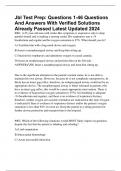-
1. Exam (elaborations) - Medical jbl test prep questions and answers with verified solutions 100% correct late...
-
2. Exam (elaborations) - Jbl final guide questions and answers with verified solutions already passed!!!
-
3. Exam (elaborations) - Jbl airway test questions and answers with verified solutions already passed!!!
-
4. Exam (elaborations) - Jbl practice exam 4 questions and answers with verified solutions 100% correct!!!
-
5. Exam (elaborations) - Jbl practice exam 3 questions and answers with verified solutions already passed (gra...
-
6. Exam (elaborations) - Jbl test prep questions 277-322 questions and answers with verified solutions 100% co...
-
7. Exam (elaborations) - Jbl practice exam module 5 questions and answers with verified solutions already pass...
-
8. Exam (elaborations) - Module 2 - exam review – jbl questions and answers with verified solutions 100% cor...
-
9. Exam (elaborations) - Jbl registry practice test questions and answers with verified solutions latest updat...
-
10. Exam (elaborations) - Jbl emt exam 1 questions and answers with verified solutions 100% correct!!!
-
11. Exam (elaborations) - Jbl navigate test prep – medical questions and answers with verified solutions alre...
-
12. Exam (elaborations) - Emt jbl mod exam 9 questions and answers with verified solutions 100% correct!!!
-
13. Exam (elaborations) - Exam 2 jbl quizzes and answers with verified solutions 100% correct!!!
-
14. Exam (elaborations) - Jbl emt exam 2 2024 questions and answers with verified solutions already passed !!! ...
-
15. Exam (elaborations) - Jbl emt - module 5 exam questions and answers with verified solutions already passed!...
-
16. Exam (elaborations) - Emt jbl operations practice test questions and answers with verified solutions alread...
-
17. Exam (elaborations) - Practice test jbl ems operations questions and answers with verified solutions 100% c...
-
18. Exam (elaborations) - Cardiology jbl test prep questions and answers with verified solutions 100% correct!!...
-
19. Exam (elaborations) - Emt jbl mastery exam 1 questions and answers with verified solutions already passed!!...
-
20. Exam (elaborations) - Emt exam 2 chap 9-13 (jbl) questions and answers with verified solutions already pass...
-
21. Exam (elaborations) - Jbl exam mod 7 emt questions and answers with verified solutions already passed rated...
-
22. Exam (elaborations) - Emt exam 4 chap 19-23 (jbl) questions and answers with verified solutions 100% correc...
-
23. Exam (elaborations) - Emt final exam jblearning questions and answers with verified solutions already passe...
-
24. Exam (elaborations) - Emt jbl mod exam 4 questions and answers with verified solutions already passed!!!
-
25. Exam (elaborations) - Jb test prep emt questions and answers with verified solutions already passed latest ...
-
26. Exam (elaborations) - Jb learning emt exam part 2 questions and answers with verified solutions already pas...
-
27. Exam (elaborations) - Jbl chapter 30 quiz/test questions and answers with verified solutions 100% correct!!...
-
28. Exam (elaborations) - Jb learning exam 1 (ch 1) questions and answers with verified solutions already passe...
-
29. Exam (elaborations) - Emt chapter 14 jbl questions and answers with verified solutions 100% correct!!!
-
30. Exam (elaborations) - Emt chapter 38 jbl questions and answers with verified solutions already passed lates...
-
31. Exam (elaborations) - Emt chapter 2 jbl questions and answers with verified solutions 100% correct!!!
-
32. Exam (elaborations) - Emt chapter 41 jbl questions and answers with verified solutions already passed!!!
-
33. Exam (elaborations) - Jbl chapter 2 questions and answers with verified solutions 100% correct!!!
-
34. Exam (elaborations) - Chapter 36 jbl questions and answers with verified solutions already passed!!!
-
35. Exam (elaborations) - Jbl test 10 - chapters 34-38 questions and answers with verified solutions already p...
-
36. Exam (elaborations) - Jbl practice test questions and answers with verified solutions 100% (graded a+)
-
37. Exam (elaborations) - Nremt prep- jbl patient assessment questions and answers with verified solutions alre...
-
38. Exam (elaborations) - Jbl questions (chapters 1-8) questions and answers with verified solutions already pa...
-
39. Exam (elaborations) - Emt jbl review questions and answers with verified solutions 100% correct!!! latest u...
-
40. Exam (elaborations) - Jbl test prep: questions 1-46 questions and answers with verified solutions already p...
-
41. Exam (elaborations) - Emt jbl quiz 1 questions and answers with verified solutions already passed latest up...
-
42. Exam (elaborations) - Jbl midterm questions and answers with verified solutions already passed!!!
-
43. Exam (elaborations) - Jbl chapter 15 questions and answers with verified solutions already passed latest up...
-
44. Exam (elaborations) - Jb learning test prep questions and answers with verified solutions already passed la...
-
45. Exam (elaborations) - Emt jbl ch.8 questions and answers with verified solutions 100% correct!!!
-
46. Exam (elaborations) - Emt jbl review (mod 4a) questions and answers with verified solutions already passed!...
-
47. Exam (elaborations) - Jbl chapter 28 quiz/test questions and answers with verified solutions already passed...
-
48. Exam (elaborations) - Emt jbl ch 1 questions and answers with verified solutions already passed latest upda...
-
49. Exam (elaborations) - Emt-test #3 (end of chapter and jbl hw q's) questions and answers with verified solut...
-
50. Exam (elaborations) - Jbl trauma practice questions and answers with verified solutions already passed late...
-
51. Exam (elaborations) - Jbl test prep: questions 645-690 questions and answers with verified solutions 100% c...
-
52. Exam (elaborations) - Jbl quiz questions: exam 3 questions and answers with verified solutions already pass...
-
Show more




